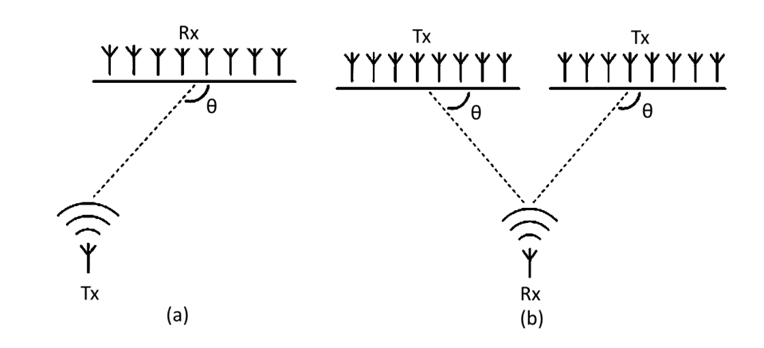
Ensuring a seamless transition between outdoor and indoor localization for the user has been a major research topic in the IoT sphere for several years. In a first article, we presented different indoor location algorithms by comparing their level of accuracy, simplicity of deployment and deployment costs.
In this new technical article, we will present the different methods of calculation of indoor positioning. Among others, we will discuss the direction finding and telemetry methods used by suppliers of indoor positioning solutions.
1. Received signal strength (RSS) to calculate the indoor positioning
RSS or RSSI is a measure of the received radio signal power. Distance estimation using this measurement principle requires prior knowledge of the path loss models of RF transmitters obtained either empirically or statistically. Generally, propagation path loss increases with increase in distance and operating frequency. The accuracy of distance estimation using this approach depends strongly on the accuracy of the path loss model used. RSS-based ranging and positioning techniques are popular since they don’t require high complexity hardware and are relatively cheaper and easier to implement25. However, RSS-based range estimation using RF signals is less accurate and less reliable in presence of obstacles. Multipath propagation and shadowing from obstacles cause challenges for RF wave propagation as RF electromagnetic waves are easily reflected and strongly attenuated by obstacles. Also, significant deviation in RSS values of RF waves can be seen due to human presence, as the direct Line-of-Sight (LOS) is blocked because of the absorption of electromagnetic waves in RF band by the human body. On the other hand, it is an extremely simple method to implement that requires few hardware resources.
2. Time of Flight (TOF) or Time of Arrival (TAO) to calculate the indoor positioning
TOA measurement represents the exact time taken by the signal to travel from the transmitter to the receiver. In this case distance travelled by the signal can be calculated from TOA measurement and the propagation speed of signal (usually the speed of light). Most notable example of range estimation using TOA measurements is the GPS. In general, direct TOA based positioning results in two problems. First, all transmitters and receivers in the system must be precisely synchronized. Second, a timestamp must be labeled in the transmitting signal for the measuring unit to discern the distance the signal has traveled. To have a good precision you need wide bandwidth signals such spread-spectrum signals or very short pulses. Also, noise, reflections, multipath, and scattering of the signal cause errors in ranging. In multipath situations, it is difficult to identify the first path of the signal to obtain accurate TOA measurement. TOA measurements with Two-Way Ranging (TWR) does not require synchronization between transmitters and receivers as it considers bidirectional communication path of the signal, and the Round-Trip Time (RTT) can be calculated using offset time between transmitter and receiver.
3. Time difference of arrival (TDOA)
TDOA is a technique to determine relative position of the target transmitter based on the difference in time at which the signal arrives at multiple reference receivers instead of considering absolute arrival time used in TOA technique. The position can be obtained as the intersection of several hyperbolas corresponding to each reference receiver. This technique requires highly precise synchronization between the reference receivers. Precision of TDOA based distance estimation depends on criteria such as the characteristics of the signal (signal modulation and bandwidth), SNR, environment (multipath propagation and interference).
4. The phase difference of arrival (PDOA)
PDOA method translates difference in phase of arrival measurements of the multifrequency carrier signal into the distance between the transmitter and the receiver. This method is based on dual-frequency radar technique for range estimation. In PDOA technique, two continuous wave signals of different frequencies with frequency difference Δf between them are transmitted. At the receiver, the phase difference Δφ is measured. The distance between the transmitter and the receiver is proportional to Δφ and inversely proportional to Δf. Because of the presence of extremely small signal bandwidth phase estimation error can be very small. This method is limited because of the requirement of the complexity of the hardware for phase of arrival measurements and the need of multifrequency carrier signal.
5. Angle of Arrival (AOA) and Angle of Departure (AOD) measurement to calculate the indoor positioning with high accuracy
AOA and AOD measurement principles rely of angle measurements to estimate the direction of RF transmitter and receiver, respectively. Phased array of antennas is deployed at the receiver and the transmitter respectively for direction finding using AOA and AOD. The accuracy of angle measurements is limited by multipath reflections, shadowing and directivity of the antennas. To achieve good accuracy in direction finding, accurate orientation information of stationary locators is required in addition to complex hardware providing accurate angle measurements. The Bluetooth core specification 5.1 provided by Bluetooth Special Interest Group (SIG) include a direction-finding feature that makes it possible to detect the direction of a Bluetooth signal. With Bluetooth direction finding feature, either AOA or AOD method can be used for direction estimation with the help of phased array antennas.

This indoor positioning calculation method used by QUUPPA is embedded in our AOA range of high accuracy location tags.
6. Channel Status Information (CSI)
CSI was introduced as an index to improve upon the limitations of the RSS. RSS provides only the information of strength of the signal, while the CSI provides more fine-grained physical layer information. In addition to signal strength information, phase shift information of the individual signal components is provided by CSI. Thus, main path of received signal can be easily distinguished from the reflections of the signal. In the case of fingerprinting, CSI provides more information compared to RSS for fingerprinting thereby improving positioning accuracy. CSI associated with different deep learning approaches allow to obtain more precise positioning results.
What you need to know about interior positioning calculation methods
Today there is a wide choice of methods for calculating interior positioning. Each method has its advantages and disadvantages. It is advisable to compare these different methods of calculation according to your needs of precision or the type of infrastructure desired. In a third article, we will present you the different indoor positioning technologies in depth.





